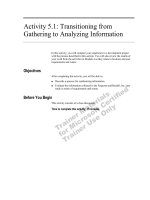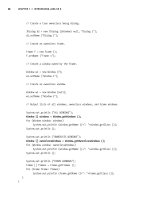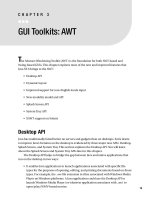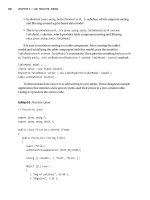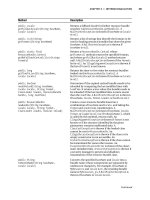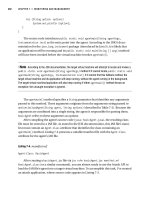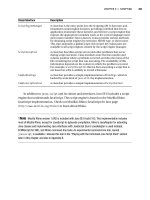- Trang chủ >>
- Mầm non - Tiểu học >>
- Lớp 5
5 6 3 from salt to silk precious goods (social studies)
Bạn đang xem bản rút gọn của tài liệu. Xem và tải ngay bản đầy đủ của tài liệu tại đây (7.16 MB, 14 trang )
Suggested levels for Guided Reading, DRA,™
Lexile,® and Reading Recovery™ are provided
in the Pearson Scott Foresman Leveling Guide.
From Sa l t to Si l k :
Precious Goods
Genre
Expository
nonfiction
Comprehension
Skills and Strategy
• Compare and
Contrast
• Draw Conclusions
• Answer Questions
Text Features
•
•
•
•
Captions
Graphs
Headings
Maps
by Laura Johnson
and Joanna Korba
Scott Foresman Reading 5.6.3
ISBN 0-328-13585-2
ì<(sk$m)=bdfifb< +^-Ä-U-Ä-U
Vocabulary
commodities
excavating
luster
malleable
microorganisms
Reader Response
1. Use a Venn diagram like the one below to compare
any two of the precious commodities discussed in
this book. How are they similar? What are the key
differences?
From Sa l t to Si l k :
Precious Goods
Commodity 1
Commodity 2
Both
molten
preserve
synthetic
Word count: 2,867
by Laura Johnson
and Joanna Korba
2. According to the graph on page 21, when did oil
production begin to exceed the actual amount of oil
discovered?
3. Find the words harmless and harmful on page 4. How
have the suffixes -less and -ful changed the meaning
of harm? Find other words in the book with the
suffixes -less and -ful. Give definitions for these words.
4. Many precious goods are in short supply. What good
do you predict might become precious in the next
hundred years? Why do you think so?
Note: The total word count includes words in the running text and headings only.
Numerals and words in chapter titles, captions, labels, diagrams, charts, graphs,
sidebars, and extra features are not included.
Editorial Offices: Glenview, Illinois • Parsippany, New Jersey • New York, New York
Sales Offices: Needham, Massachusetts • Duluth, Georgia • Glenview, Illinois
Coppell, Texas • Ontario, California • Mesa, Arizona
Every effort has been made to secure permission and provide appropriate credit for
photographic material. The publisher deeply regrets any omission and pledges to
correct errors called to its attention in subsequent editions.
Unless otherwise acknowledged, all photographs are the property of Scott Foresman,
a division of Pearson Education.
Consider these common expressions used to
describe a person’s worth—or worthlessness: Lee is
the salt of the earth. Lee is worth his weight in gold.
Lee is a diamond in the rough. Poor Lee! You can’t
make a silk purse out of a sow’s ear. What do these
expressions have in common?
All involve goods—gold, diamonds, silk, and salt—
that were precious commodities in ancient times.
Diamonds and gold are still highly valued today. Silk,
while it is still valued, is now a popular, relatively
affordable fabric that many people are able to
buy. Salt, however, can be found on everyone’s
table. You’re probably surprised to see it included.
While salt has ceased to be a precious commodity,
something else has come along to take its place—oil.
What makes something a precious commodity?
For one thing, it must be wanted. For another, it
must be rare. Generally speaking, the more scarce
something is, the more money it can bring. Buyers
must desire the commodity badly enough to spend
lots of money willingly to acquire it.
Photo locators denoted as follows: Top (T), Center (C), Bottom (B), Left (L), Right (R),
Background (Bkgd)
Opener (T) ©Richard T. Nowitz/Corbis, Opener (B) ©Anthony Bannister; Gallo Images/
Corbis; 1 ©Charles O’Rear/Corbis; 3 (BR) ©Charles O’Rear/Corbis, 3 (BL) ©Bill Ross/
Corbis, 3 (BC) ©Randy Faris/Corbis; 4 (T) ©Richard T. Nowitz/Corbis; 8 (Bkgd) ©Anthony
Bannister; Gallo Images/Corbis; 11 ©Hulton Archive/MPI/Getty Images; 12 (Bkgd)
©Charles O’Rear/Corbis; 14 ©Bettmann/Corbis; 16 (Bkgd) ©Japack Company/Corbis;
18 (Bkgd) ©Bill Ross/Corbis
ISBN: 0-328-13585-2
Copyright © Pearson Education, Inc.
All Rights Reserved. Printed in China. This publication is protected by Copyright,
and permission should be obtained from the publisher prior to any prohibited
reproduction, storage in a retrieval system, or transmission in any form by any
means, electronic, mechanical, photocopying, recording, or likewise. For information
regarding permission(s), write to: Permissions Department, Scott Foresman, 1900 East
Lake Avenue, Glenview, Illinois 60025.
4 5 6 7 8 9 10 V0H3 14 13 12 11 10 09 08 07 06
3
Over the years, the hot desert sun evaporated
water in the salty Dead Sea, leaving behind
huge salt deposits.
Salt, an Ancient Treasure
As you sprinkle some salt on your vegetables
tonight, think about this: In ancient China, a spoonful
of salt could be traded for an ounce of gold. In
ancient Rome, salt was used as money. Roman citizens
could pay their taxes with salt, and Roman soldiers
were given salt as part of their pay. In fact, our word
salary is derived from the Latin word for salt, sal.
(Latin was the language of the ancient Romans.)
Salt is a harmless mineral formed from two
potentially harmful elements: sodium and chlorine.
Sodium is an unstable metal that can suddenly burst
into flame. Chlorine is a deadly gas. When the two
react, they form sodium chloride, or table salt.
4
The Value of Salt
In ancient times, the main way to preserve food
was to salt it. There were no refrigerators to keep
food from spoiling quickly. And ancient peoples
didn’t know how to can goods to keep the contents
germ free.
Salt was also highly valued, and still is, as a
seasoning. But it is more important to humans than
that. Ancient peoples didn’t know it, but salt, like
water, is essential to the health of our cells. Without
both water and salt, our cells would die—and so
would we.
People needed and wanted salt. In addition, it
was hard to obtain. Salt is found almost everywhere
on Earth, but this was not known until the last
century. Before then, salt was searched for and
fought over.
There are two main sources of this popular
mineral. Seawater contains about 3.5 percent salt.
Ancient peoples got salt from the sea by pouring
ocean water into huge basins that they left in the
sun to evaporate. This process took a long time and
could only be done in hot, sunny regions with easy
access to saltwater.
Salt can also be found underground, in huge
deposits that are the remains of prehistoric oceans
buried millions of years ago. Getting this salt requires
locating, excavating, and operating salt mines.
5
Trading in Salt
In early times, salted food was traded, since it
was lighter and easier to handle than heavy bags of
salt. Around 2800 B.C., the ancient Egyptians began
trading salted fish to another ancient people, the
Phoenicians, who had established trade cities all
around the Mediterranean.
There was a wealth of salt to be gotten from
another part of Africa. But there was a problem. The
salt was in dried-out lake beds in the vast Sahara,
the largest desert in the world. How could it be
transported from deep in the scorching Sahara to
various trade cities in West Africa?
The solution was to domesticate an animal that
could survive intense heat and a lack of water:
the camel. About a thousand years ago, traders
began dealing directly in salt, traveling trade routes
from the Saharan salt mines to the coast of the
Mediterranean.
People and camels journeyed together in
caravans. Once the caravan reached the coast, the
salt was loaded onto ships sailing to European ports.
Major cities, such as Genoa and Pisa in Italy and
Lisbon in Portugal, were centers of the salt trade.
By the Middle Ages, caravans of as many as 40,000
camels laden with salt and other goods were making
the long trek through the Sahara.
Deep-drilling technology, introduced in the early
1800s, provided easier access to underground salt
deposits. And the need for salt as a preservative
disappeared with advances in canning and
refrigeration. What was once a precious commodity
has now become a basic part of our everyday lives.
Fez
M E D I T E R R A N E A N
0
0
500
500
S E A
1000 Miles
1000
1500
Kilometres
It took as long as six months for caravans from
West Africa to reach the Mediterranean coast.
6
7
Silk, a Prized Secret
The Value of Silk
Silk is an elegant fabric from an inelegant
source—a worm. The creature in question, known as
a silkworm moth, is native to China. It lives its first 45
days as a worm, feeding on leaves (preferably from a
mulberry tree). Once grown, it wraps itself in a sheath
called a cocoon. Inside, the silkworm undergoes a
dramatic change, emerging as a moth. During its brief
adulthood (lasting only two or three days), the moth
does not eat and rarely flies. It does mate though, and
the female lays 300–500 eggs before dying.
The silkworm’s cocoon consists of one continuous
silken thread. It is this thread that is unraveled,
twisted together into thicker strands of thread, and
woven into silk cloth.
Silk is the strongest of all natural fibers. Silk cloth
is light, cool, and smooth, with a fine luster. It takes
dye well and can be produced in a variety of rich
colors. The Chinese discovered how to turn silkworm
cocoons into silk cloth almost 5,000 years ago. For
hundreds of years, they fiercely guarded the source
of their silk and their silk-making process.
About 3,000 years ago, the Chinese began trading
silk cloth abroad. Not too long after, caravans were
regularly carrying silk to India, Persia (now Iran), and
elsewhere. Silk—so beautiful, so rare, and so secret—
was in great demand.
For a thousand years more, the Chinese were
able to keep their secret. By the second century A.D.,
though, India was producing and shipping its own
raw silk. Legend has it that the person responsible
for revealing the secret of silk was a Chinese princess.
In leaving her homeland to marry a foreign prince,
it was said, she smuggled some silkworms and
mulberry leaves with her, along with the secret for
how to weave silk. Why did she do this? According
to legend, she wanted to be sure she would always
have lovely silk dresses to wear in her new home.
The silkworm spins its
cocoon from a single
silk thread that is
about 1,000 yards long.
8
9
The Silk Road
Silk was so important a commodity that a major
trade route was named for it—the Silk Road. This
system of caravan tracts linked China with the
West. Traders made their way back and forth on
these roads, trading in silk and other goods. Camel
caravans, similar to those involved in the salt trade,
were common sights along the Silk Road.
Before there were sea routes connecting the East
and the West, the Silk Road was the most important
trade route between these two worlds. The 5,000mile-long Silk Road began in China and wound
its way around deserts and over mountains until
it reached the shores of the Mediterranean. From
there, goods were shipped across the sea.
The desire of the West for the silk of the East
was of major importance in linking China to Europe.
Ideas were exchanged, as well as goods. Over the
centuries, however, the Silk Road became less and
less safe. Bandits often preyed upon caravans,
robbing them of their precious cargo. The Silk Road
began to fall into disuse.
In modern times, what was once a major trading
route has become, in part, a highway between
Pakistan and China. There is no more need for a Silk
Road. After all, the silk-making process is no longer
a secret. Silk farms, which raise silk worms in large
numbers and spin their threads into cloth, flourish
all over the world. New synthetic fibers exist that
have replaced silk in certain types of clothing, such as
stockings. Silk is no longer a precious commodity.
This picture from a map made in the
Middle Ages shows a camel caravan
traveling along the Silk Road.
10
11
Gold, Eternal Symbol of Wealth
The Value of Gold
Throughout human history, gold has been a
symbol of wealth and power:
Gold possesses several qualities that have made it
highly prized over the centuries. It has an attractive,
distinctive color and luster. It is tremendously durable
and nearly impossible to destroy. It does not tarnish
or rust. It is soft and easy to shape, so it is ideal for
making into jewelry or coins.
In addition to being prized for its qualities,
gold is also difficult to acquire. Most of it is buried
deep underground and is hard to reach. Only a
small amount is pushed up near the surface by
underground forces. When it is discovered in rocks,
gold is always found mixed with other, less valuable,
metals. Deposits of pure gold, known as lode
deposits, are very rare.
The main sources of gold in the ancient world
were nuggets found around rivers and streams. As
underground rocks became exposed on the surface,
running water ate away at them. Deposits of metals
and minerals were washed away into streams. Soft
gold forms into clumps called nuggets, unlike the
smaller particles of harder metals. These streambed
nuggets are known as placer deposits.
In ancient times, rich placer deposits of gold were
found in China, India, Persia, and lands around the
Aegean Sea. During the Middle Ages, the major
sources of gold in Europe were in Saxony (northern
Germany), Austria, and Spain.
• When the ancient Egyptians buried their kings in
huge underground tombs, they filled the chambers
with treasures that largely consisted of gold.
• The ancient Greeks celebrated it in myth—King
Midas and his deadly golden touch, the golden
fleece sought by Jason and his Argonauts.
• In the Middle Ages, European inventors vainly
experimented, hoping to find a way to turn other
metals into gold, the metal they prized most.
• Spanish conquistadores, or conquerors, invaded
Mexico and Peru in the 1500s, searching for the
mythical city of gold called El Dorado.
Gold is a soft yellow metal that is malleable.
This means that it can be stretched and beaten into
different shapes. The ancient Egyptians hammered it
into thin sheets called leaves.
Many current world governments keep
reserves of gold in the form of bricklike
bars called ingots.
12
13
OREGON
aS
G R E A T
American
River
S
RR
A
V
A
n
D
De
A
q
ui
EN
J
San Jose
NEVADA
EI
Stockton
na
S
San Francisco
B A S I N
Carson City
SutterÕs
Mill
Sacramento
ao
CALIFORNIA
SI
ER
RA
SA
DRE
AF
AE
LM
TNS
.
MOJAVE
DESERT
Los Angeles
od
aro
PACIFIC
OCEAN
MA
NR
aV
ht
a
Monterey
yell
Gold prospectors place a load of dirt in a container, pour in
lots of water, and swirl the dirt around. They are hoping to
wash away everything but some gold nuggets.
IDAHO
Pyramid
Lake
ma rc
Eureka
otne
After Columbus claimed America for Spain, the
flow of gold into Europe increased enormously. Most
of it came from Central and South America. Mines
under European control were excavated and worked,
using slave labor. Temples filled with gold treasures
were looted by Europeans. From 1492 to 1600, more
than 225,000 kilograms of gold from South America
were exported abroad. But this did not keep the
world from wanting more.
The second great golden era dawned with the
discovery of gold at Sutter’s Mill in California in 1848.
Tens of thousands of prospectors, hoping to strike
it rich, descended on the little settlement between
Sacramento, California, and Carson City, Nevada.
Although a few lucky souls were able to find enough
gold to make them rich, it was primarily merchants
who got wealthy as the population of California
mushroomed. By 1850, two years after the Gold Rush
began, California had grown so much that it applied
for statehood.
A third “golden era” occurred between 1890
and 1915, with the discoveries of gold in Alaska, the
Yukon (Canada), and South Africa.
Gold continues to be a precious commodity today.
It is crafted into expensive jewelry. It is used in many
electrical and electronic devices, including televisions
and computers. Thin gold coatings on the surfaces of
spacecraft and office windows have a cooling effect
because they reflect the infrared rays of the sun.
R T S A O C
G N A
S E
leE
The Rush for Gold
AR
loC
14
California became a state
on September 9, 1850.
15
Diamonds, Dazzling and Durable
The Value of Diamonds
Diamonds are the crystallized form of pure
carbon. You may have heard human beings described
as “carbon-based life forms.” Carbon is indeed
the basis of all living things and can be found in
combination with other elements in all plants and
animals.
A diamond is carbon in its most concentrated
form. It is the hardest substance known. Not
surprisingly, the word for this unique crystal is
derived from a Greek adjective, adamas. The ancient
Greeks used this adjective to describe anything that
was so hard, it could not be destroyed.
Diamonds are extremely rare and difficult to
find. The conditions for their formation—intense
pressure and heat—only occur deep within Earth.
Diamonds began to form over a billion years ago,
more than 90 miles under continents and some 125
miles under the ocean floor. Some reach the surface
in molten rock that is forced up through breaks in
rocks. Some become trapped near the surface. The
first diamonds, like gold, were probably found in
streambed deposits. Mines later became the primary
source.
Their rarity is not the only thing that makes
diamonds so precious, however. They are also highly
prized for their bright, flashing beauty. To achieve
this beauty, a “diamond in the rough” must go
through a long and involved process. Diamonds
mined from the earth must be sorted by hand on the
basis of size, quality, shape, and color.
After sorting, a diamond must be skillfully cut
and polished to produce the flashing stone that is
so highly prized. As the hardest of all substances, a
diamond can only be cut by another diamond. It is
generally believed that the art of diamond cutting
in Europe arose in Venice sometime after 1330,
with diamond cutters using iron wheels coated with
diamond dust. These days, diamond saws are used.
A chemically pure diamond is colorless. The addition of any
other elements adds color, such as yellow from nitrogen or
blue from boron.
16
17
The Diamond Trade
Oil, a Precious Natural Resource
For about a thousand years, beginning around
the fourth century B.C., diamonds were only mined
in India. No one knows exactly when diamonds first
appeared in the West. The earliest mention of these
gems is in Roman writing from around A.D. 100.
By the mid-1300s, Venice had become the
diamond-trading capital in Europe. In the early days
of European diamond trade, these precious gems
were reserved for royalty. By the 1600s, wealthy
members of the aristocracy were wearing them as
well.
India continued to be the sole source of diamonds
until 1725, when diamonds were discovered in Brazil.
In the 1870s, major finds in South Africa created a
dramatic increase in the production of diamonds.
Today, the major producers are Australia, Russia,
South Africa, Botswana, and Congo Republic.
About 80 percent of the world diamond trade
is overseen by a single organization, the Central
Selling Organization. It strictly controls the quantity
and quality of diamonds on the market. In short,
it ensures that diamonds continue to be a precious
commodity.
These days, the news is filled with talk of rising oil
prices and fears that the world will run out of oil.
Often called “black gold,” oil formed long ago
when prehistoric organisms and microorganisms
died and drifted down to the ocean floor. They were
buried under sand and then subjected to pressure
and heat. Subsequent chemical changes led to the
formation of crude, or unrefined, oil. The pressure of
Earth forced it upward into less dense rock until the
oil was stopped by rock that it could not penetrate.
The oil stayed where it was for thousands of
centuries, soaking into the rock like water into a
sponge. Occasionally, some seeped to the surface.
The World’s Leading Oil Consumers, 2004
China 7.5%
Japan 6.8%
United States 25%
Rest of World 22%
18
Germany 3.5%
Russia 3.5%
India 3.0%
South Korea 2.9%
Canada 2.7%
France 2.6%
Italy 2.5%
Brazil 2.3%
Mexico 2.3%
United Kingdom 2.1%
Spain 2.1%
Saudi Arabia 1.8%
Iran 1.5%
Indonesia 1.5%
Netherlands 1.2%
Taiwan 1.2%
Thailand 1.1%
Australia 1.1%
19
The Value of Oil
Ancient people collected oil from large seeps.
They used the heavy fluid to dress wounds and,
finding that oil was flammable, in their lamps. It was
not a precious commodity back then.
It wasn’t until the twentieth century that the use
of oil really became widespread. Petroleum, refined
into gasoline, was found to be the best fuel to use
in the popular new invention—the automobile. The
increasing demand led to improved techniques for
extracting oil. By the beginning of the twentieth
century, oil fields were in operation in fourteen
states as well as in Europe and the Far East.
As the century progressed, the need for oil
became critical. Planes, ships, trains, and cars needed
oil as a fuel. Millions of people heated their homes
with oil. Now, we simply can’t live without it.
Sometimes the demand for oil has led to war. In
1990, Saddam Hussein, then leader of Iraq, ordered
his army to invade neighboring Kuwait, hoping to
take control of its vast oil fields. The United States
successfully reclaimed the fields for Kuwait in a war
known as the Gulf War.
Experts keep reminding us that it is only a matter
of time before we run out of oil altogether. Some
believe it will be within the next hundred years. The
fact is, oil may be the most precious commodity of all!
The Growing Gap
60
Past Discovery
Since oil drilling began in 1859, roughly 50,000
oil fields have been located. Over 90 percent of
them have little effect on the world production of
oil. Only two types of oil fields are truly significant:
supergiants and world-class giants. Fewer than
forty supergiants have been found worldwide,
representing about half of the oil discovered thus
far. Twenty-six of them are in the Persian Gulf. The
oil-rich countries in this region include Kuwait, Saudi
Arabia, Iran, and Iraq.
20
50
Billions of Gallons
The Oil Trade
Production
40
30
20
10
0
1930
1940
1950
1960
1970
1980 1990
2000
21
Now Try This
Create a Precious Goods Board Game
Divide up into small groups. Each group‘s job is to
create a board game. The spaces on the game board
will be labeled with the names of cities along a trade
route. The game boards can then be traded and the
game played by other groups.
to Do It!
w
o
H
s
’
e
r
He
1. One or two group members use books or the
Internet to identify ten cities along the route
of your choice.
2. Other group members label the spaces with city
names and illustrate the board with drawings
of precious goods.
3. Artistic members may design two game pieces,
such as camels or traders.
4. Based on the facts in the book, have each person
in your group write questions about a different
commodity: salt, gold, silk, diamonds, or oil.
Each group should write a total of 10 questions.
Write the questions on one side of an index card.
Write the answers on the opposite side.
5. Trade games with another group and take turns
playing in groups of three. Have one person read
the questions. Have the other two players take
turns answering the questions. If the answer is
correct, the player moves his or her game piece
to the next city along the trade route. If the
answer is incorrect, the player moves back a space.
The first player to reach the end of the trade
route is the winner.
Advance across a trade route by answering
questions about precious goods you have read about.
22
23
Glossary
Vocabulary
commodities
commodities
n. any things
that are bought and sold.
excavating
excavating
v. exposing
or uncovering by digging
out,
as a mine.
luster
luster n. soft reflected
malleable
light;
sheen.
malleable adj. able to be
microorganisms
shaped
or formed as by
hammering or pressure.
Reader Response
molten adj. made liquid
by heat; melted.
preserve v. to prevent
something, such as food,
from decaying or spoiling.
synthetic adj. created by
humans rather than found
in nature; artificial.
1. Use a Venn diagram like the one below to compare
any two of the precious commodities discussed in
this book. How are they similar? What are the key
differences?
Commodity 1
Commodity 2
Both
molten
microorganisms
n.
organisms so small that
preserve
they
can only be seen
with a microscope, such as
bacteria.
synthetic
Word count: 2,867
2. According to the graph on page 21, when did oil
production begin to exceed the actual amount of oil
discovered?
3. Find the words harmless and harmful on page 4. How
have the suffixes -less and -ful changed the meaning
of harm? Find other words in the book with the
suffixes -less and -ful. Give definitions for these words.
4. Many precious goods are in short supply. What good
do you predict might become precious in the next
hundred years? Why do you think so?
Note: The total word count includes words in the running text and headings only.
Numerals and words in chapter titles, captions, labels, diagrams, charts, graphs,
sidebars, and extra features are not included.
24
